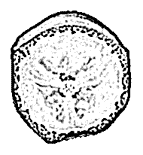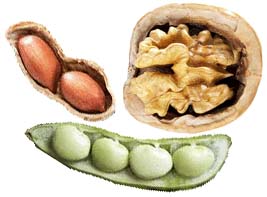The main cutaneous folds on the human body
You can only see a small portion of your cutaneous folds. However, you can feel all of them with your nails.
Fold types
The folds in the skin of your body can be classified into several types, determined by their angle, origin and location.
Horizontal folds
Horizontal folds are the most common and obvious.
Everybody has visible horizontal folds on their forehead, neck, elbows, wrists, fingers, knees, ..., yet most horizontal folds are hard to detect visually.
Horizontal folds keep on developing all your life.
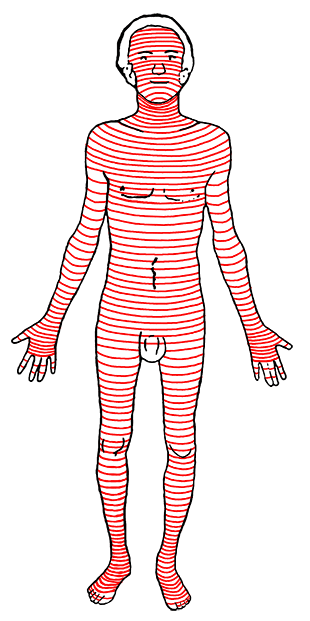
Though the main reason for horizontal folds is gravity, they mostly occur when the body, or any of its parts, is bent or flexed at articulations.
Horizontal fold formation
As soon as the fetus starts moving, around the sixth week, its actions create horizontal folds in the skin.
Even if the horizontal folding starts very early; the initial vertical folds are already in place.
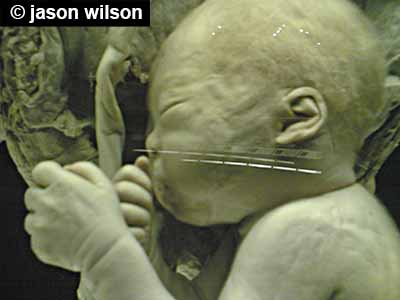
Before birth, some horizontal folds are already so etched-in that they become permanent folds.
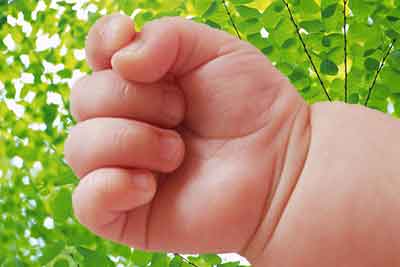
Permanent folds compress the skin and reduce the action of the muscles, blood vessels and nerves that pass beneath them.
This baby's wrist is tiny, but already strangled.
As the body grows and the wrist enlarges, the constricting effect worsens.
Horizontal folds deepen and multiply as a person ages.
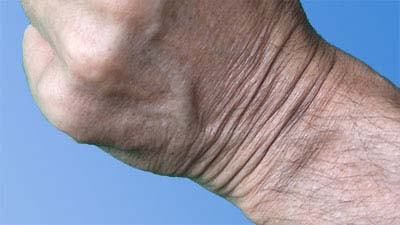
For more information on children and cutaneous folds
Horizontal folds and on-axis articulations
Most horizontal folds occur in places where the body can be flexed perpendicularly.
Articulations can be divided into two types:
• On-axis articulations; like those of your knees, creating horizontal folds,
• Off-axis articulations; like those of your thumbs, creating diagonal folds.
Most articulations are on-axis because their movement is perpendicular to the body, so flexing them produces horizontal folds.
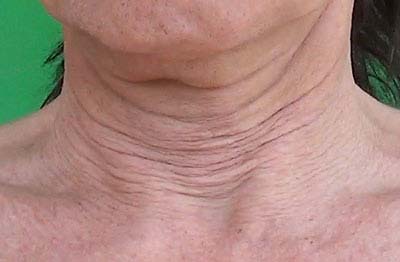
Horizontal folds can also be found between articulations and along stretches of skin that cover bones where no bending or flexing occurs.
These folds may be smaller and shallower than those at articulations, they still can be the source of pain or aesthetic problems.
Compressed and stretched horizontal folds
The skin that surrounds an articulation is like a bent pipe.
The folding creates different kinds of folds on each side.

Stretched folds
On one side of the articulation, the stretched side, flexing inwards causes the skin to expand and stretch, so it covers a larger area.
But, when the articulation returns to its straight position, the folds in the skin create the draping effect we are familiar with.
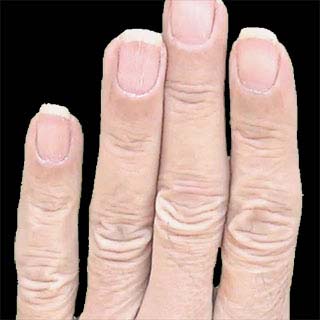
Besides the aesthetic problems that the dangling skin can cause, stretched folds can be painful.
If you close the articulation inwards, the folds prevent the skin from expanding the way it should and pain is felt.
Compressed folds
On the other side of the articulation, the compressed side, flexing inwards compresses and crushes the skin.
This creates deep and tight folds where the skin is hardened.
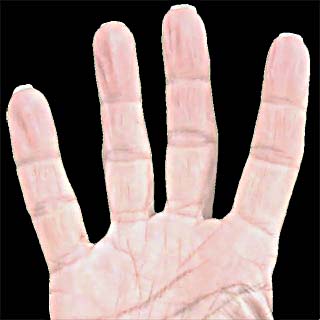
Compressed horizontal folds pull the skin inside the articulation, more and more each day.
This prevents the articulation from closing completely, but it can cause pain every time the articulation is used.
Horizontal folds, articulations and pain
Most horizontal folds are formed in places where the skin covers an articulation.
Articulations are complex mechanisms, made of bone and cartilage, that can be flexed thousands of times every day.
The fragile skin that surrounds them is badly battered by their moving parts.
Horizontal folds are formed and they grow larger and deeper.
They squeeze the joint more and more every time it is activated.
At some point, the skin is pulled-in so deeply that it gets pinched and crushed by the hard parts of the articulation.
You end up with pain every time you move the joint.
Knee X-ray - Wikipedia
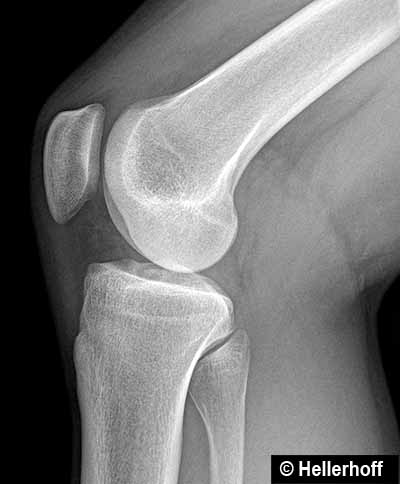
At first, the pain may appear only when the articulation is fully extended, fully contracted or over-used.
People will respond by reducing the amplitude and force of their movements to avoid the pain.
With time, every joint of the body becomes completely strangled by folds, so every action becomes unpleasant and painful.
This pain explains why some elderly people can hardly move anymore.
Vertical folds
The main vertical folds that run up and down your body are different from all your other folds.
Vertical folds are special because they originate from the formation of your embryo, in the first weeks of your life.
They are so fundamental that they pass unnoticed and people don't consider them as folds.
In this illustration, vertical folds are shown as being equal. In reality, those placed on simple fractions of the body (½, ¼, ...) are much deeper.

Vertical folds divide your body into halves, quarters, eighths, ....
They are very long.
Some go all the way up your body on one side, then down on the other side.
They circle your body vertically.
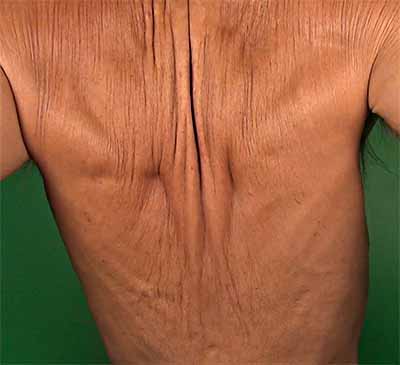
Notice the two huge fold crossings, (the craters in the center of this image), where the vertical folds meet the tip of the shoulder blade.
The skin has fastened itself to the shoulder blade, and any movement you make pulls on the surrounding folds; often causing pain that may be part of your headaches, your back pains or your shoulder pains.
The most important fold
The vertical center fold
The vertical center fold is the biggest and most significant fold on your body.
It goes up and down the center of your body, from your head to your buttocks.
It divides you into two symmetrical halves, creating a right and a left side of you.
Many features and organs located on one side of the center fold are reproduced on the other side, but inverted.
When you observe its route, you understand that your body is divided into two distinct sections that are joined along this line.
Press your nails anywhere along this line; and you will feel the fold.

The central vertical fold is responsible for all kinds of particularities and deformations along its path.
Your navel, your larynx, your mouth, your nose, your hair whorl, your spine, your anus, your buttock crease, your urethra and sexual organs all fall on its path.
On your back, it follows your spine, but the skin is completely entangled into it.
The vertical center fold is obvious and easily visible in many places on the body, yet, despite its importance, this physical feature is completely overlooked.
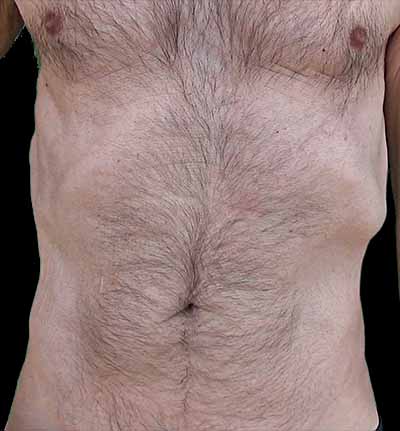
Observe how attached to the bone your skin has become along the vertical center fold's path.
If you pass your nails on it, you will feel that the skin is hard and folded inwards.
This fold is so important that it is accompanied, on each side, by companion folds.
The companion folds are parallel to the center fold staying less than one inch away.
This external division of your body is also present in some internal organs such as your brain.

Initial vertical folds have a fetal origin
Initial vertical folds are those that originate from the very early development of the fetus.
The phenomenon could be a consequence of the cell multiplication process.
Three week old embryos are clearly divided into two halves.

Since initial vertical folds were formed first, all other types of folds form cutaneous fold crossings at their intersections.
Your skin is like a banana peel or a molded object
While the other folds on your body are caused by repetitive movements and positions, fundamental vertical folds divide the body into distinct sections.
These folds remind me of the seams we see on a banana peel, on pods, nuts, seeds, ...
Their surface is not really round, it has ridges, seams.
We also observe analogous lines on molded objects made out of chocolate or plastic indicating that two or more parts have been assembled.
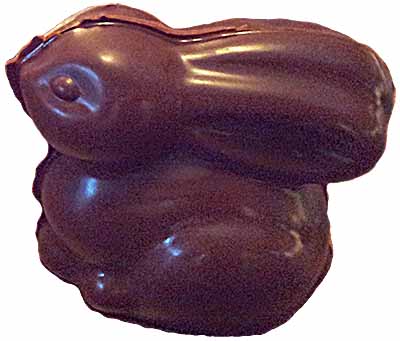
Your body has similar squareness.
Vertical folds are placed at precise angles of your body.
Other important vertical folds
The vertical front/back fold
It separates the front and the back of your body.
Just like the central vertical fold, it divides your body into two halves, but on the other axis.
It is the longest fold of all.
Picture it as a line splitting your body into two parts as if you were viewed from the side.
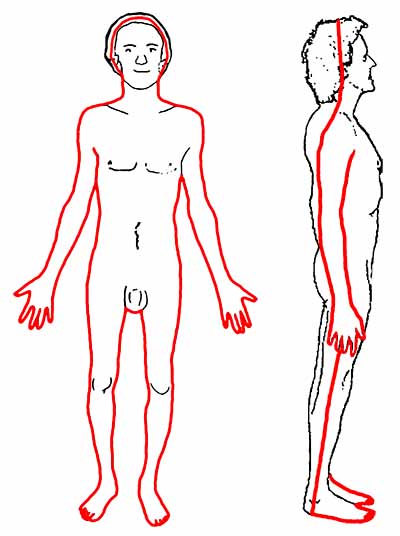
It runs up and down the sides of your arms and legs, going into the detail of the side of every finger or toe.

If you're six feet tall, your vertical side center fold is over sixteen feet long.
The vertical quarter folds
They split you into quarters by re-subdividing each side created by the vertical center fold.
Even if these folds aren't as deep as the center fold, they generate pain and aesthetic problems when large horizontal folds cross them.
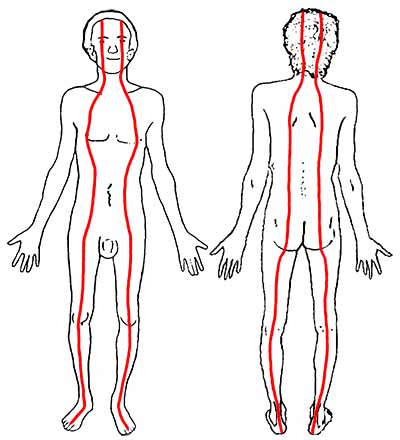
Their path passes straight in the middle of your eyes, breasts, knees and feet.
Diagonal folds
Diagonal folds cross the skin at an angle; instead of straight up and down or sideways.
On your body, you'll find much less diagonal folds than vertical or horizontal ones.
While vertical and horizontal folds are long and circular (they go completely around the body), diagonal folds are shorter and not necessarily circular.
They make the junction between deep fold crossing points in the vertical-horizontal grid of folds.
We can distinguish:
• Off-axis articulation diagonal folds
• Folds that follow the bones or muscles
• Angled repetitive movement diagonal folds
Off-axis articulation diagonal folds
While most articulations on your body are on-axis (they cross the body straight vertically or horizontally), the articulations that move your shoulders and hips, along with the ones you use to close your hands or feet, are angled (off-axis).
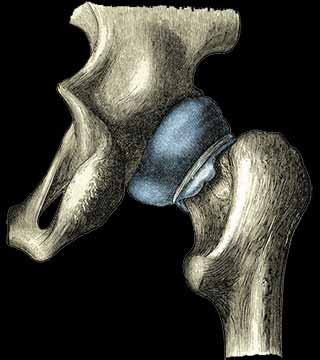
Since these off-axis articulations are used so frequently, deep folds are formed weeks before birth and keep on developing all through your life.
We can observe:
• Shoulder off-axis diagonal articulation folds
• Hand off-axis diagonal articulation folds
• Hip off-axis diagonal articulation folds
• Foot off-axis diagonal articulation folds
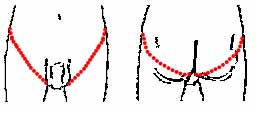
When you close your hand, you bring back your fingers towards your thumb at an angle; this creates diagonal folds.

Folds that follow the bones or muscles
Your skin molds itself to whatever is beneath it.
When it covers a ridge, a crease or any type of edge, folds are formed that follow the path of the unevenness.
Your skin does this to protect itself.
By firmly attaching itself to the bone, the muscle or whatever, it limits all skin movements in the area.

In order to grasp the bone, muscle, tendon, ... beneath it, your skin needs places that protrude or create some type of ridge.
It folds and refolds on any edge until it grabs it.
It will affix itself to each vertebra of the spine in your back.
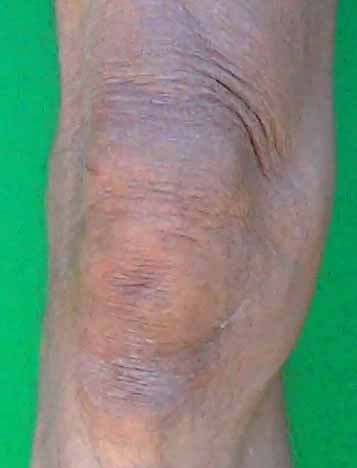
When muscles are beneath the skin tissue, it will gladly fasten itself to them.
Humans are convinced that they have muscle pain; when muscles cannot produce the kind of acute pain they feel.
In fact, the pain comes from the folded skin that grasps the muscles.
Even muscle cramps or muscle spasms are caused by fold crossings; not the muscles.
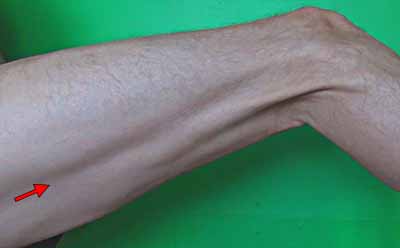
Angled repetitive movement diagonal folds
Many people make repetitive gestures while they work.
Some movements can be done and redone thousands of times a day.
The skin folds created by these actions will grow, become permanent and, at some point, generate some pain.
But, if the gestures involved are off-axis; diagonal folds will form and the pain can be much worse.
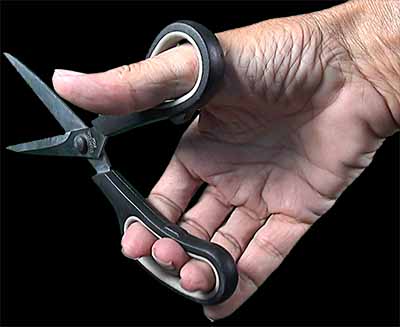
Facial expression folds
The facial nerve, one of twelve cranial nerves, is in charge of facial expressions and taste.
Facial muscles are under its control and convey your emotional state.
This is the most natural and effective way to communicate for humans.
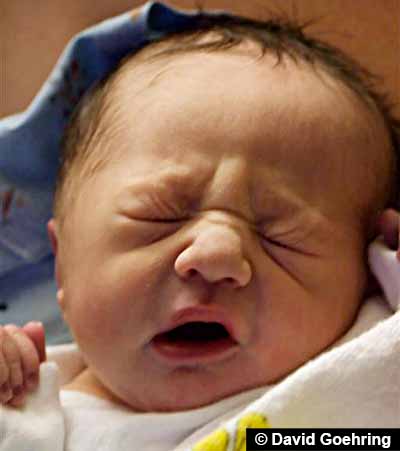
The skin gets profoundly folded by facial expressions.
The intensity of the feelings they express is conveyed to the depth of each fold.
Since these expressions are used regularly and sometimes held for long periods, the skin would be damaged if it didn't protect itself.
It coats the bottom of each fold with fresh coats of epidermis cells to harden the skin.
However, the expression folds now become engraved in the face of the individual.
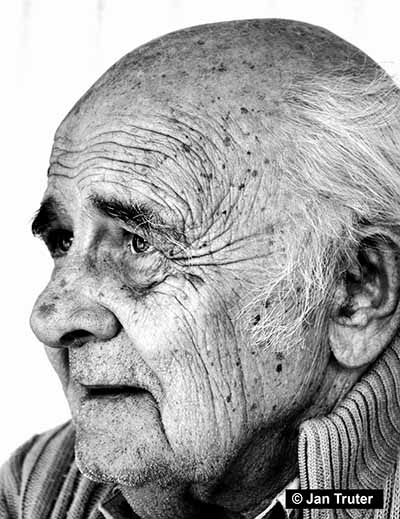
Your face is like a record of all those smiles and worries.
The expressions you hold most often have become carved into your skin mostly in the mouth, eye and eyebrow areas.

Since the expressions you've used the most in your life are engraved on your face, displaying new ones becomes more difficult.
The action of your facial muscles is hampered by all your folds and this limits your expressiveness.
Your face is supposed to be a blank screen on which your emotions can be projected without interference from your past.
For more information on facial expressions
Body orifice folds
Your skin is a tissue, but it's full of holes.
We can observe holes:
• for the eyes,
• for the ears,
• for the nose,
• for the mouth,
• for the breasts,
• for the navel,
• for the anus,
• for the vagina,
• for the urethra,
• for each fingernail,
• for each toe nail.
These openings are unique and complex skin formations and many of them have mobility.
You have grown specific folds for each of these regions: mouth folds, eye folds, ear folds and so on.

Horizontal and vertical folds surrounding these openings try to ignore them; so, when they reach the orifice, many folds will continue their path on the other side.


For many of these orifices, the skin transforms itself when it reaches the opening.
For the mouth, for example, the skin tissue changes into lip tissue, then into mucous membrane.
Curiously, the folds don't stop; they keep on inside the cavity if they can.
Posture folds
Posture folds are found in places where the skin bears the weight of the body.
Humans have three main postures resulting in a set of particular folds for each one:
• Standing folds; beneath the feet
• Lying folds; on the back
• Sitting folds; on the buttocks
The skin gets crushed in the areas that are in contact with the surface supporting it.
This creates a small pocket of refolded skin just above this junction.
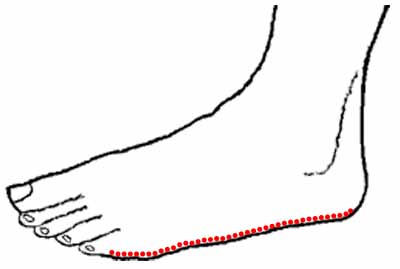
Of course, how often and for how long the posture is adopted, along with the weight of the person, will have a determining effect on the size of the folds.
Posture folds can also form in any place where you rest or lean on; supporting all the weight of a member against a surface.
Wear folds
Wear folds are formed in places where objects or fabrics put pressure on the skin.

Wear folds are usually caused by wearing:
• Head wear
• Glasses
• Clothes
• Jewelry and watches
• Foot wear

People don't realize the harm they're doing to their skin by wearing these things.
If you can't stay away from them, at least minimize the harm they can do by:
• Wearing them less often or for shorter periods,
• Choosing the lighter models,
• Staying away from elastic bands and tight fastening,
• Wearing only molded footwear with socks inside.
|
|
Next page
|
